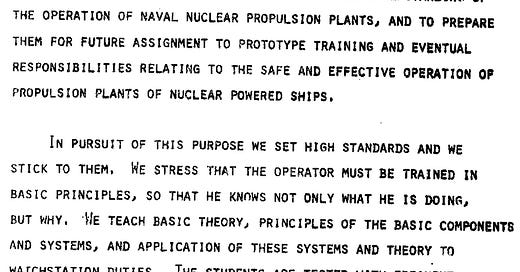After eight weeks of Temporary Duty at Boston Naval Shipyard aboard the USS Gearing (DD-710), I received orders to join Nuclear Power School (NPS) Class 70-3 in Bainbridge, MD1, which was scheduled to begin in August 1970.
I hopped in the blue 1967 Camaro my brother Mike left me when he went to Vietnam, and headed down I-95 to Maryland from my home in Framingham, MA. Unlike me and my three other younger brothers, who all joined the Navy like our father and his father before him, Mike had enlisted in the Army. To atone for that transgression he became a Franciscan friar when he left the military.
NPS is arguably the military’s most academically challenging school, with courses in mathematics, nuclear physics, radiation/health physics, reactor principles and technology, material science and metallurgy, electrical theory and generating equipment, thermodynamics, and chemistry. If you’re interested, NPS study materials are available on the NAVSEA website.
Admiral Rickover, the father of the nuclear navy, personally approved the curriculum, and was obsessed with training on the fundamentals. His May 1979 statement to the House Committee on Science and Technology says it best:
Click HERE for the full document.
Students needed to score at least a 2.5 grade point average in each subject to graduate - “two-five and survive” was the mantra, and the 10% or so who did not survive were reassigned to non-nuclear billets in the fleet.
I attended classes for 40 hours per week and spent at least another 10-20 hours most weeks studying. My Pickett slide rule got quite a work-out since calculators were not yet widely available.
I still remember several mnemonics my instructors taught us, like the one for the 6-factor formula for K-effective2, “Every Little F-ing Puke Loves the F-ing Navy”, and several others related to motor and generator theory I hesitate to reiterate due to their graphic nature.
I graduated in January 1971 with a 3.2 average without having to attend the mandatory supervised remedial study sessions assigned to those running short of 2.5. In retrospect, I should have spent more time studying, as Admiral Rickover told me in no uncertain terms nine years later when I interviewed unsuccessfully for an assignment with Naval Reactors (NAVSEA 08), but that’s another story. In my defense, I had married my first wife Sue while attending NPS, which diverted my attention from academics.
Upon graduation, I received orders to S1C prototype in Windsor Locks, CT for the next phase of training.
Next up: I become a qualified nuclear operator.
There was a second NPS in Mare Island, CA, and the two schools were combined in 1986 with Nuclear Field A School in Orlando, FL, which was subsequently moved to Goose Creek, SC in 1998 as part of the Base Realignment and Closure program.
Keff = e Lf P Lt f n. K-effective is basically a ratio of the number of neutrons generated by fission in one generation divided by the number of neutrons in the previous generation left over after a bunch of them get lost on their way to fission. A reactor is critical and self-sustaining if Keff is greater than or equal to one, and will shut down on its own if it’s less than one. You can Google it if you want a more detailed/accurate explanation.




